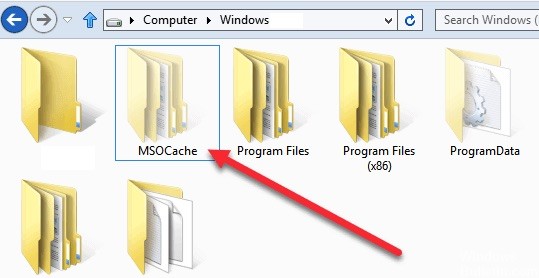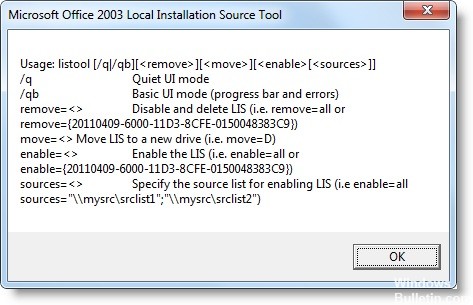Updated February 2025: Stop getting error messages and slow down your system with our optimization tool. Get it now at this link
- Download and install the repair tool here.
- Let it scan your computer.
- The tool will then repair your computer.
One morning, when you open my computer, you will see a hidden folder called Msocache that takes up a lot of hard disk space in a partition of your hard disk that has a lot of free space. What is this Msocache file? Why is it in my computer? How can I remove it to recover the free space?

If Microsoft Office is installed on your hard drive, you probably have a hidden folder called C: MSOCache. This is used to facilitate repairs and reinstallations of Microsoft Office features, but can consume a lot of disk space.
To check if the MSOCache folder exists
- First open Windows Explorer. From the top menu, select Tools, then Folder Options. A new window opens. Go to the View tab and access the Hidden Files and Folders section.
- Switch from “Do not display hidden folders or drives” to “Display hidden files, folders and drives”. This is sufficient to see if the MSOCache file exists on the computer system.
- Open the c: drive in Windows Explorer and check that the MSOCache folder is present.
- Right-click on the folder and select Properties to display the folder size on your hard disk. This can range from 430 megabytes if Office 2007 is installed, to more than 750 megabytes for Office 2010.
Is it safe to delete the MSOCache?

If you want to delete the MSOCache, don’t just delete the folder – it leaves orphaned registry entries, which can be a problem if you try to modify your Office installation in the future. Instead, use Microsoft’s Local Installation Source (LIS) tool.
February 2025 Update:
You can now prevent PC problems by using this tool, such as protecting you against file loss and malware. Additionally, it is a great way to optimize your computer for maximum performance. The program fixes common errors that might occur on Windows systems with ease - no need for hours of troubleshooting when you have the perfect solution at your fingertips:
- Step 1 : Download PC Repair & Optimizer Tool (Windows 10, 8, 7, XP, Vista – Microsoft Gold Certified).
- Step 2 : Click “Start Scan” to find Windows registry issues that could be causing PC problems.
- Step 3 : Click “Repair All” to fix all issues.
To move the MSOCache to another drive, launch a command prompt:
listool.exe move=DriveLetter
Where DriveLetter is the drive on which you want to move the cache.
If you are on an emergency diet, you may have to do without it. Deleting files requires high permissions. This does not affect the functioning of Office applications, but attempts to install new features fail.
To restore the cache later, you must perform a Microsoft Office repair installation from the installation CD or DVD. I can’t guarantee that this trick will work for all versions of Microsoft Office, but I was able to remove the cache for Microsoft Office 2010.
Alternative to deleting the folder
Most users are annoyed by the space the folder occupies in the root directory, so we have developed an alternative that requires users to move the MSOCache folder to another directory without losing functionality. To do this, we will create a node between the two drives.

- Open the drive on which the MSOCache folder is to be saved, right-click anywhere and click the New Folder option.
- Name the folder “C (The Root Directory)” and press “Enter”.
- Right-click on the MSOCache folder and select Cut.
- Navigate to the “C” folder in the other folder we just created and paste the folder there.
- When the copy is finished, press Windows + R to open the command prompt.
- Type “CMD” and press “Enter” to open the command prompt.
- Enter “CD \” and press “Enter”.
- Type the following command and press Enter.
MKLINK /J MSOCache D: \C\MSOCache
Enter “Exit” and press “Enter”.
https://superuser.com/questions/216300/can-i-delete-msocache
Expert Tip: This repair tool scans the repositories and replaces corrupt or missing files if none of these methods have worked. It works well in most cases where the problem is due to system corruption. This tool will also optimize your system to maximize performance. It can be downloaded by Clicking Here
